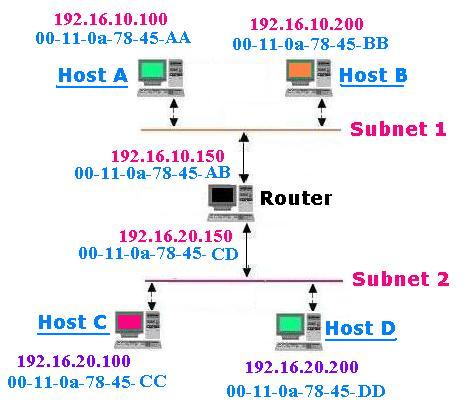Address Resolution Protocol (ARP) & Proxy ARP
1. DLC
Short for Data Link Control; that is the second lowest layer (Data Link) in the OSI Reference
Model. Any host as a node on the network has an interface card (NIC) which contains a DLC
address or DLC identifier (DLCI) that identifies it on the network. The Ethernet and Token-Ring
protocols use exclusively the DLC addresses ; whereas others such as TCP/IP, use instead a logical
address at the Network Layer (the third lowest layer) to identify nodes. The networks that conform
to the IEEE 802 standards (e.g., Ethernet), the DLC address is called the Media Access Control (MAC)
address.
The request of the physical addresses (DLC or MAC) uses a specific protocol. In TCP/IP networks, the
request is performed with the Address Resolution Protocol (ARP).
2. ARP & RARP
Short for Address Resolution Protocol. It is done on the network layer (level three). Its purpose
is to get the Ethrenet address (MAC) of the wanted to reach host on the network. A host asking for a physical
address broadcasts an ARP request onto the TCP/IP network.
The host on the network that has the IP address in the request then replies with its physical hardware
address.
The Reverse RARP, asking for the IP address, knowing the DLC or MAP , a host uses the RARP broadcasts its
physical address and a RARP server replies with the host's IP address.
3. Proxy Address Resolution Protocol (ARP)
Proxy ARP is the technique in which the host router, answers ARP requests
intended for another machine. By proxy the router accepts responsibility for
routing packets to the accurate destination. It is set in order to fetch the
physical address from machines on a subnet.
The main advantage of a proxy ARP is that it can use a single router on a network for communication with
the all the machines on the network. the disadvantage is that hosts on the network think that all the other
machines are reachable by an ARP request, then increase the amount of infomation in their ARP tables.
4. How does that work?

The Host A (192.16.10.100) on Subnet1 needs to send packets to Host D (192.16.20.200) on Subnet2.
At first, it will check if the destination address is in its routing table.
The host A and the host D are in the same primiraly network : 192.16.0.0 (the subnet mask is /16
Class B network). Forethermore nothing can tell the host A that it needs a router to reach D. For A, It
seems that it is directly connected to the host D.
But to reach D, A has to know its IP address, but also its MAC. A knows the IP Address, but not the Mac.
A sends broadcasts then an ARP request on the subnet1; requesting that Host D will send its MAC address.
Sender's MAC Address 00-11-0a-78-45-AA Sender's IP Address 192.16.10.100
Target's MAC Address 00-00-00-00-00-00 Target's IP Address 192.16.20.200
The ARP request packet is encapsulated in an Ethernet frame with Host A's MAC address as
the source address and a broadcast 192.16.10.255 as the destination address.
Since the ARP request is a broadcast, it reaches all the nodes in the Subnet A, including the router
via its interace ( toward Subnet1). The broadcast will not reach Host D because routers, by default,
do not forward broadcasts.
The router knows that the host D target's address is on the Subnet2 and can reach it.
The router replies then with its own MAC address to Host A, using the D's IP adress.
Sender's MAC Address 00-11-0a-78-45-AB Sender's IP Address 192.16.20.200 Target's MAC Address 00-11-0a-78-45-AA Target's IP Address 192.16.10.100
The proxy ARP reply packet is encapsulated in an Ethernet frame with router's MAC address
as the source address and Host A's MAC address as the destination address. On receiving this
ARP reply, Host A updates its ARP table as folows:
IP Address 192.16.20.200 MAC Address 00-11-0a-78-45-AB
At tis point, from now on, the host A will forward all the packets destined to the Host D (192.16.20.200)
to the router (00-11-0a-78-45-AB). Since the router knows how to reach Host D, the router forwards the packet
to the host D.
5. The ARP Cache
The ARP cache on the hosts in Subnet1 contains the MAC address of the router for all the hosts on Subnet2.
Forethermore, all packets destined to Subnet2 are sent to the router. The router, by proxy, forwards those
packets to the hosts in Subnet2.
The ARP cache of Host A is as follows:
| IP Address | MAC Address |
| 192.16.20.200 | 00-11-0a-78-45-AB |
| 192.16.20.100 | 00-11-0a-78-45-AB |
| 192.16.10.150 | 00-11-0a-78-45-AB |
| 192.16.20.150 | 00-11-0a-78-45-AB |
| 192.16.10.200 | 00-11-0a-78-45-BB |
We have multiple IP addresses are mapped to a single MAC address (the router's MAC address), indicating that proxy ARP is in use.
The router's interface can easily configured to enable or disable a proxy ARP. By default, it's enabled.